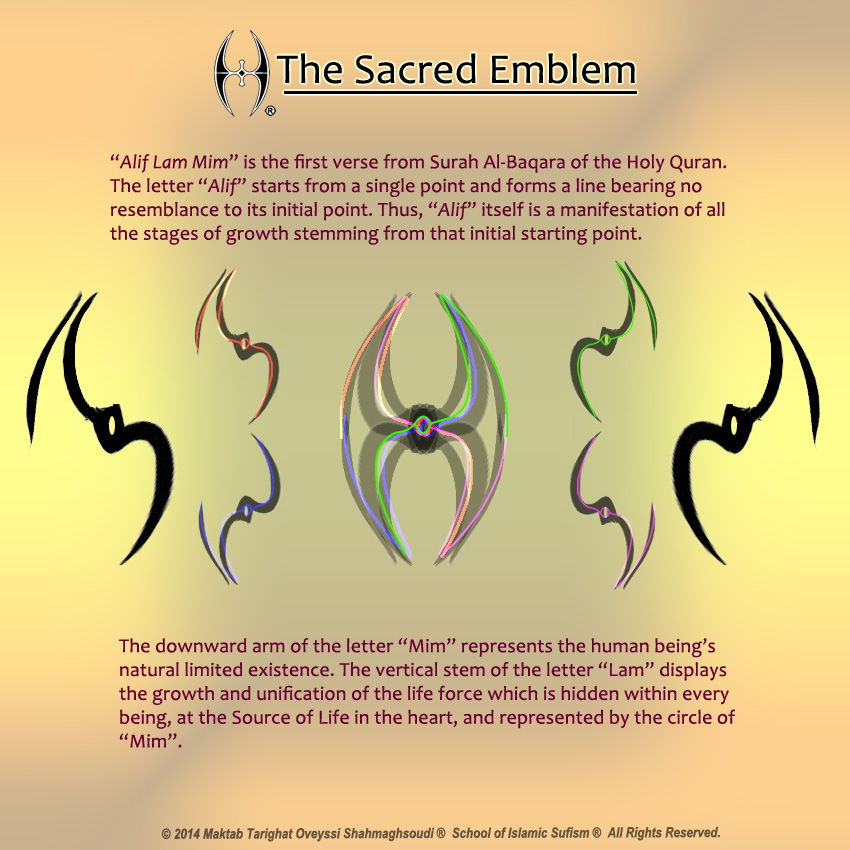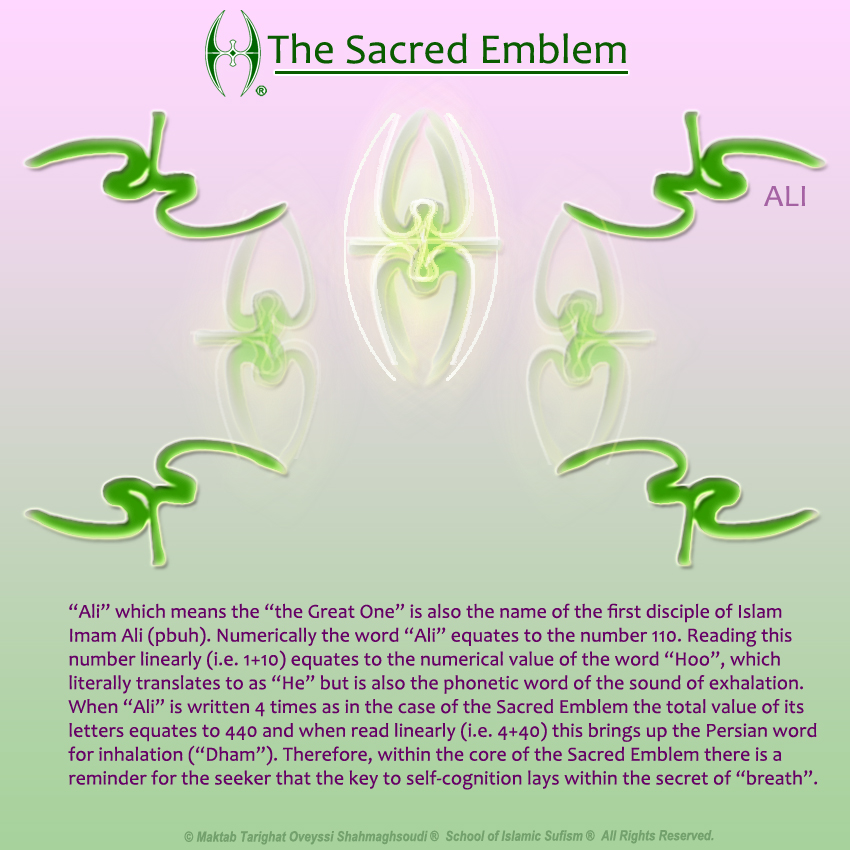About Sufism
Origin, Principles & Practice
All about Sufism
The school dates back 1400 years to the time of Prophet Mohammad (peace be upon him), and the founder of the school, Hazrat Oveys Gharani. The knowledge and practices of the school have been handed down heart to heart through an unbroken succession of Masters from Hazrat Oveys to Sufi Master, Hazrat Salaheddin Ali Nader Angha.
Origin
The Origin of Sufism
The Sacred Emblem





Sufism has existed since the beginning of human history, for in every time and place, God has sent Prophets to lead mankind to knowledge of Him, and Sufism is the Way of the Prophets. The great Master Bayazid Bistami (qtd al-Muqaddisi) stated: “Its seeds were set at the time of Adam, they sprouted under Noah and flowered under Abraham. Grapes formed at the time of Moses, and they ripened at the time of Jesus. In the time of Mohammad, they were made into pure wine.”
Historical records of Sufism date back to the seventh century, to the time of Prophet Mohammad (peace be upon him), when it was founded by Oveys Gharani. Sufism is generally accepted to be the mystical dimension of Islam. Hujwiri, in the eleventh century, presented several views of the origin of the term, “Sufi”. Some scholars say Sufism is derived from the word Ahl al-Suffa, or the People of the Bench, which refers to the platform on which the Holy Prophet Muhammad and the believers used to sit while worshipping God. 1
Others say that they were named Sufis because of their habit of wearing suf (wool). The habit of wearing wool next to the skin dates back to the first master of Islamic Sufis. While this theory of the derivation of the word does have a foundation in the practices of Sufism, the words of Hazrat Mir Ghotbeddin Mohammad Angha clarify this point: “While every Sufi wears wool, not every person who wears wool (suf) is a Sufi.” 2 Others have concluded that Sufis were named so because of the safa, or purity of their hearts and the cleanliness of their actions. Therefore, the practitioners of safa are called Sufis meaning “pure-hearted.”
The Sufi Pir, Hazrat Salaheddin Ali Nader Angha tells us that while this allusion by historians is not incorrect, it is incomplete. They have presented the outer form of Sufism, while its inner meaning has been beyond their personal experience. If we look closely at the last three hypotheses we will note that there are certain requirements in order to be called a Sufi. To be a companion of the Prophet surely requires a different mode of action and behavior. It requires purity of heart, spiritual awareness, and sacredness of goal. In essence, the people of the Bench, or the companions of the Holy Prophet, must have been aware of the significance of the teachings of the Holy Prophet and must have been intent on being trained by him because they wanted to know God. 3
Thus if wearing wool was one of the conditions, they did so. Wearing wool was a mere reminder not to surrender to earthly absorptions. The aim was to reach a state of purity, through which they would be in direct relationship with God, unite with God, be annihilated in God, subsist in God, and then attest to the Oneness of God as the Holy Prophet had declared: la-illaha-illallah. Reaching this state would be safa, meaning that no other but God is in one’s heart.
This method of purification through submission to God and annihilation in God was termed ma’rifa, meaning acquaintance and cognition. In this context it refers to the cognition of oneself and therefore cognition of God. The one who teaches this method of cognition is known as the arif, or he who has attained the most exalted state of existence through annihilation and permanence in God. The esoteric wisdom of cognition was transmitted from the Holy Prophet to his cousin and son in-law Ali ibn Abu Talib also known as Amir al-Mo’menin (peace be upon him).
The sanctity of the message of Islam and the tradition of the Holy Prophet were kept intact through an unbroken chain of transmission by the great masters of Maktab Tarighat Oveyssi Shahmaghsoudi®.
References:
1. Ali B. Uthman Al-Jullabi Hujwiri, The Kashf Al-Mahjub, Trans. R.A. Nicholson (London: E.J.W.Gibb Memorial, 1911-1976) Print.
2. Salaheddin Ali Nader Angha, Sufism (Washington, DC: M.T.O. Publications®, 1996) Print. p.12
3. Ibid., p.12-13
Principle
The Principles of Sufism
M.T.O. Sufism® teaches principles of Sufism that facilitate the journey of self-knowledge. The journey to one’s inner realm and the state of one’s soul is called Sayr-va-Solouk. The spiritual teacher known as the Pir, meaning “the light of the path,” guides the seeker through this journey of Self-knowledge. The guiding light of the teacher illuminates the seeker’s path and enables him to overcome the obstacles on this journey. The present Sufi Master of M.T.O. School of Sufism®, Hazrat Salaheddin Ali Nader Angha presents the eight principles of Sufism as follows: 1
These principles facilitate the journey of self-knowledge. First, the seeker of Truth becomes more in control of all natural appetites, desires, and dependencies (physical, mental, emotional, etc.). As a result, the seeker feels an inward release and a sense of balance, freedom and peace. The constant external attractions that pulled him in different directions no longer control him.
The Pir enables the seeker to liberate himself from the layers of ignorance and misteachings and leads him through the seven stages of the heart from the stage of genuine yearning for love and knowledge to the highest stage of unity and annihilation. By observing the above principles, the seeker undergoes various stages of purification where the veils of the unknown are lifted. With faith and knowledge, the seeker attests to the Oneness of God and the Unity of Existence.
The Sufis have described the states of the heart in respect to the seven heavenly spheres. The Sufi poet Attar, in a richly allegorical poem called The Conference of the Birds, describes the mystical pilgrimage as a quest that begins with the removal of all earthly desires, then progresses through love, knowledge, and a sense of amazement, and ultimately to annihilation which is uniting with God.
The story recounts the longing of a group of birds who desire to know the great Simorgh, the beloved king. The birds under the guidance of a leader (Hoopoe) with passion and enthusiasm start their journey toward the land of Simorgh. But one by one, they drop out of the journey, each offering an excuse of why they are unable to endure the journey. Eventually only thirty birds or si morgh (in Persian) remain as they finally pass through the Seven Valleys and arrive in the land of Simorgh. They seek permission to see the Simorgh, but their request is turned down. The thirty birds, or si morgh, in love and rapture annihilate and die from their physical realm, and enter the realm of their soul. To their amazement, there they realize that in fact the great Simorgh they have been seeking all along is their own true identity. In other words, the Simorgh or the truth is the si morgh or the reality of the thirty birds. They realize this has been a journey of self-knowledge for them to discover their truth.
In this story, the hoopoe who leads the birds is used as an allegory of a Sufi master leading his pupils to enlightenment. The birds must cross seven valleys in order to find the Simorgh. These valleys represent the stages that a seeker of the truth must pass through in order to cognize God through cognizing his/her true self. 2
References:
1. Salaheddin Ali Nader Angha, Kanzol-Soluk :Wealth of Cognition (Tehran, Iran: MTO Publications®, 1986) p.33-34
2. Farid ud-Din Attar, The Conference of the Birds (New York: Penguin Press, 1984)
3. Shah Maghsoud Sadegh Angha, Al-Rasael: The Light of Salvation (Tehran: M.T.O. Shahmaghsoudi Publications ®, 1987) p.106-110
Practice
Practical Aspects of Sufism®
The Practical Aspects of Sufism® are integral to the inward learning and discipline necessary for purification and the attainment of true self cognition. The students of Sufism use the practices with love and devotion to develop and unfold their hidden abilities. The Sufi Master guides the student through every moment of their journey to self-knowledge.
References:
1. Hazrat Shah Maghsoud Sadegh Angha, Hidden Angles of Life (Pomona, CA: Multidisciplinary Publications, 1975)
2. Angha, Hazrat Shah Maghsoud Sadegh. Al-Salât, the Reality of Prayer in Islam (Riverside, CA: M.T.O. Shahmaghsoudi Publications®, 1998), p.20
3. Hazrat Salaheddin Ali Nader Angha, (Lecture, Pleasant Hill, CA, 1992)
MTO Tamarkoz® (M.T.O. Meditation)
The Sufi Meditation is called Tamarkoz® (M.T.O. Shahmaghsoudi Meditation®), meaning Concentration of Abilities which differs markedly from what Westerners call meditation. Tamarkoz® creates a state of equilibrium, balance and harmony in all dimensions of one’s being. This powerful and precise method of inward cognition and self-discovery aligns, balances, and activates the energy fields of the body and facilitates the unification of mind and heart. Therefore, the seeker becomes receptive and in harmony to attain unity with the spirit. True meditation connects one with the fundamental unity of all existence.
According to the teachings of Hazrat Shah Maghsoud Sadegh Angha in the book Hidden Angles of Life, the human body is equipped with 13 electromagnetic energy centers. Cognition and development of these centers create the required harmony and facilitate discovery of the spiritual dimension of the human being. The most important of these centers resides in the heart, Molana Shah Maghsoud Sadegh Angha has referred to it as the “I” or the “Source of Life.” Tamarkoz® distinguishes Sufi techniques from other types of meditation practices. Discovery of the “I” and its attractive field is essential in cognition of the true self. 1
Zikr
The literal meaning of Zikr is ‘remembrance’, specifically remembrance of the Beloved, God.
Zikr harmonizes the human instrument to the tune of God’s remembrance. If done correctly, Zikr frees the seeker from daily distractions, thoughts, fears and worries by uniting every aspect of their being in remembrance of God. This practice activates the energy centers in the body, beginning the process of purification of the heart.
The seeker’s goal is to connect to his heart, allowing the natural rhythm and flow of Zikr to free him from all limitations.
By moving from left to right, the rhythm and motion of Zikr are dictated by the heart in the form of the infinity sign. One moves from left to right making the symbol of infinity while singing a specific phrase or verse. At the center of this infinity sign is the heart, where total concentration must reside to experience the reality within and connect to the true self, the “I”.
The love and attraction occurs at the center of the “I” in the heart of the seeker, and from there pervades his entire being. This center functions as a magnet that captures all energies, love and attraction that exist in the universe. The point of union of the two worlds, or the “I”, is embedded within us and is “awakened” through meditation and prayer, whereby the pathway between the heart and brain becomes illuminated.
Prayers (Salat)
Recitation of the daily prayers, (Salat) is a basic principle of Sufism and a pillar of Islam. The purpose of the prayers is to seek closeness to the Divine Beloved, God. The outward dimension includes purification through washing (ablution), and a series of movements and recitations. The inner dimension requires presence of heart.
This presence of heart is an essential condition for prayer. In true prayer, the heart, the recitations, and the bodily postures of the believer seek only one truth and that is the experience of the holy phrase la ilaha illa Allah (there is no god but God). The prayers are a necessary requirement for the worshiper to perform but without the appropriate inner preparedness to achieve unity with God they are devoid of meaning.
The daily prayers in Islam are a constant reminder and a source of strength for the true seeker, whose only goal is closeness to God. Hazrat Shah Maghsoud Sadegh Angha has said :
True prayer means witnessing the glorious light of God and truthful devotion to the Exalted God in the mirror of the pure, attentive, and illumined heart; the enlightened mind; and the pure and assured self.
Fasting
Fasting is a principle of Islam and a key Sufi practice. From before dawn to after sunset each day during the month of Ramadan, the sincere seeker abstains from earthly pleasures, turning inward toward the heart. Fasting means abstaining not only from food, drink, smoking and other cellular desires, but also abstaining from pollutants of the mind and soul. The fasting of Ramadan is a time of purification, requiring self-discipline and devotion to the Divine Beloved. Sufism teaches that without presence of heart and the right intention, all actions become meaningless and trivial rituals. This is also true for fasting.
Hazrat Salaheddin Ali Nader Angha, the current Sufi Master of M.T.O. Shahmaghsoudi School of Islamic Sufism®, has illuminated the spiritual significance of Ramadan and the reality of fasting in his teachings. The word “Ramada” (رَمَضَ) means a land parched with the intense heat and dryness, a land which is so dry in its extreme thirst that its surface is cracked open, and the sections of the surface begin to curve up at the ends creating bowl-like shapes. The surface is almost detached from the ground facing the sky, waiting for the pure and life giving rain to quench its thirst. This represents the yearning of the body and soul of the sincere seeker of the truth during the month of Ramadan. The seeker in his or her thirst and yearning avoids and turns his back to earthly pleasures. In his solitude, he turns toward the source of Life in his heart, awaiting the flow of knowledge and love from the spring of his heart. 3
Ramadan is a month during which the Holy Qur’an was revealed by God to Prophet Mohammad (peace be upon him). This signifies that through purification and devotion, the book of seeker’s being opens and reveals the true knowledge and love, manifesting the clear signs for guidance and salvation.
The Seven Principles of Self-Knowledge
M.T.O. Sufism® teaches that each human being is a true and comprehensive unit of existence. Therefore, each human being can manifest the eternal principles of existence. However, due to personal desires, habits, imbalances, and other interferences, we do not recognize our own true nature. As a result we are only aware of a limited dimension of our own being, and remain totally unaware of the vast inherent principles of existence.
The Seven Principles of Self-Knowledge
The Seven Principles of Self-Knowledge are universal and infinite. The individual can connect with these eternal principles and cognize his or her true reality through the Source of Life in the heart, the “I” in the core of one’s being.
Hazrat Salaheddin Ali Nader Angha, in the book Theory “I” describes the fundamental principles of self-knowledge as follows:
- Principle of the Prevalent, Informed Center
- Principle of Equilibrium and Balance
- Principle of Cooperation and Collaboration
- Principle of Comprehensiveness and Unity
- Principle of Harmony
- Principle of Guidance
- Principle of Love and Attraction 1
1. Principle of the Prevalent, Informed Center
Sufism teaches that the whole of existence, from atoms to galaxies to human beings, all submit to their informed center and are guided by their innate knowledge.
The center of the “I” is the prevalent, informed center, which is the source of our infinite knowledge. The center of the “I” is like a seed of a tree. The seed contains all the potentials, capabilities, and knowledge for its development within itself. But, the seed will only grow if it is planted in a proper environment, and receives the appropriate care of a wise gardener. Under these conditions, the seed unfolds and manifests the knowledge within.
2. Principle of Equilibrium and Balance
Permanent balance and equilibrium is the result of every single unit following the guidance of its stable and informed center. This principle applies to the entire universe, and creates order and stability.
The center of the “I” is the stable center that brings all aspects of one’s life, be it the physical, mental, emotional and spiritual, into balance and equilibrium. As a result, the over doings and under doings will be minimized. Instead order, health, peace, and permanent well-being will emerge. In the book The Secret Word, Hazrat Salaheddin Ali Nader Angha states: “Equilibrium of absorptions is the point of freedom.” 2
3. Principle of Cooperation and Collaboration
The cognition of the stable center leads to equilibrium, and ultimately to cooperation and collaboration. In the example of the seed, the harshness of the roots seems to clash with the delicacy of the flowers’ scent. However, when we look at the whole picture, we notice that every single part is in an intricate relation with the whole.
Cognition of the true “I” enables us to realize our true identity and value. It prevents us from being misled by conflicting values and from being influenced by greed, jealousy, selfishness, and unhealthy competition. It enables us to promote cooperation and collaboration at different levels of our own being, and in our environment.
Hazrat Shah Maghsoud Sadegh Angha states:
“In the infinite world, because of its unity, contrasts and antagonisms can not exist.” 3
4. Principle of Comprehensiveness and Unity
The center of the “I” is vast and infinite. When it is recognized and developed, the inherent knowledge within permeates and fulfills our entire being. As a true and comprehensive unit of existence, the human being consists of the cellular and spiritual dimensions. Both dimensions of his being, the matter and the energy, the physical and the spiritual, are enfolded in the center of the “I”, the “pivotal point” in his heart.
Unfortunately, due to mistreatment and lack of sufficient educational systems, the eternal dimension of his being does not get an opportunity to develop. It remains buried under multiple layers of ignorance imposed by social norms and habits, and has no manifestation to him. Therefore, he denies its existence, and becomes deprived of knowing himself as a unified being.
In the example of the tree, the seed is the comprehensive center. It contains within it the tree’s knowledge and potential for growth. The seed manifests its innate knowledge in two dimensions. The roots grow toward the ground, and the sprouts find its way toward the sky. The development continues in total balance and collaboration. The innate knowledge manifests in all stages in both dimensions in the form of roots, branch, leaf, flower, fruit, then…. seed again. In this process of expansion and contraction the knowledge concealed within the seed becomes manifested at different phases of its growth. At the final stage, at the core of the fruit is the seed again, manifesting the law of unity. Sufism enables us to cognize our reality as a true and vast unit of existence.
5. Principle of Harmony
It is often assumed that there exists a chasm between a human being and the universal truth, between matter and energy, and between a human being and the Creator. However, what appears as a chasm in reality is only the absence of harmony that renders the recognition of reality impossible.
To re-establish this lost harmony, the human being has only one choice: He must return to his original source of life, to the “I”, the point where “being” manifests itself in the form of matter.
The concentration of dispersed energies and potencies in the center of the heart, the “pivotal point”, provides the required harmony and equilibrium. This way, he can access his lost spiritual dimension and know his reality as a unified being. The journey of self-knowledge begins from the infinite center of the “I” and leads to absolute existence.
6. The Principle of Guidance
The reality of guidance is not cognized through external, acquired knowledge. The human being, through the journey of self-knowledge from the “i” (the limited self) to “I”, becomes in harmony with and capable of receiving guidance from the inherent knowledge and wisdom which is bestowed upon him. Guidance is possible only through individual effort; it is not a social or group phenomenon.
The seeker of the truth at the core of his being, in his heart, witnesses the light of guidance. The spiritual teacher known as the “Pir,” meaning “Light of the Path,” is the patient guide who illuminates the seeker’s path.
Hazrat Imam Mohammad Bagher, the fifth Imam of the Shi’a states: The teacher, the spiritual guide, is a pure essence which must be introduced (revealed) by God to the seeker’s heart through his divine light.
The guiding light of the “Pir” facilitates the journey. The spiritual teacher enables the seeker to reach a total level of equilibrium and harmony between all layers and stages of his being, cognize and witness his truth with certainty, and manifest his reality as a unified being.
7. Principle of Love and Attraction
The Principle of Love and Attraction transcends limited and changeable attachments, dependencies, and emotions. Love is a fundamental principle of existence, a field of attraction, and a rapture that embraces the entirety of human existence.
Hazrat Molana Shah Maghsoud Sadegh Angha states: “Love is an all–pervading electromagnetic force, which unites and connects all aspects of existence, from the smallest particle to the whole infinite universe.” 4
The seeker of the truth, through the center of “I”, connects to the love and attraction of the whole of existence. “This attraction unites every aspect of existence; it connects human beings to their source of life, to their stable center, the “I”. The center of “I” functions as a magnet that captures all energies, love, and attractions that exist in the universe.” 5
Through the power of love, all imaginary boundaries and distances are shattered and the law of La illaha illa Allah (there is no god but God), which is the law of unity, manifests. This is how the seeker of the truth, through the power of love, recognizes the reality of the teaching of Prophet Mohammad (pbuh), when he stated “You be You.” Your reality is the Reality of Existence.
References:
1. Salaheddin Ali Nader Angha, Theory “I” (Riverside, CA: M.T.O. Publications®, 2002), p.97-116
2. Salaheddin Ali Nader Angha, The Secret Word (Lanham, MD: University Press of America, 1989), p.17
3. Shah Maghsoud Sadegh Angha, The Hidden Angles of Life (Pomona, CA: Multidisciplinary Publications, 1975) p.43
4. Ibid., p.60
5.Idem., Theory “I”, p.116
